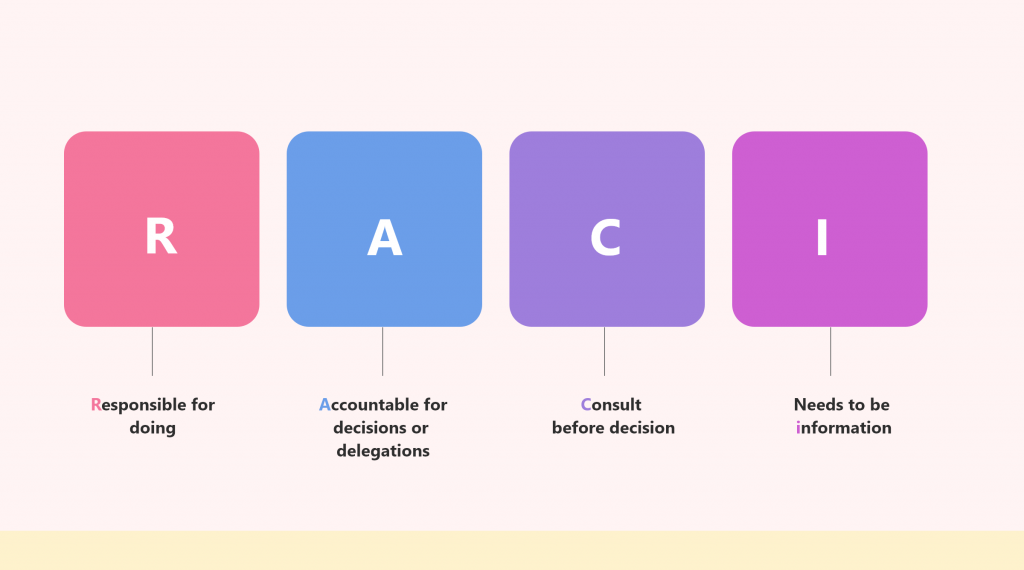
Successfully running multiple projects at the same time is not a one or two-man show. It’s a team game. And like every other team game, there has to be a coach, and he has to be adept at managing all the players on the field.
Assuming your project has a coach (supposedly, the project manager or the team leader), there’s also a need for governance for everyone in the team. This is where project management governance enters the scene.
But then, just like how a coach knows the game inside and out, you should also know how to build a framework for project governance, what challenges you may face, the benefits, and so on.
This blog is going to touch every detail, so get your coffee mug and sit back to gain a comprehensive understanding of project governance in project management.
What Is Governance in Project Management?
Project management governance is not merely a set of rules to follow; it embodies the organization’s culture and strategic intent in project execution. While traditional project management focuses on the day-to-day execution of tasks within a project, project management governance, however, takes a broader perspective.
It establishes a structured environment for decision-making, fosters accountability, and ensures alignment with the organization’s strategic objectives.
Sounds confusing? Here’s a simpler comparison –
- Traditional project management often focuses on the ‘how’ and ‘when’ of project tasks.
- Project governance addresses the ‘why’ (the strategic rationale behind project choices), ‘what’ (the outcomes they aim to achieve), and ‘who’ (those responsible for steering these initiatives to success).
Let’s check how the Project Management Institute (PMI) defines project governance –
“Governance is the framework, functions and processes that guide activities in project, program and portfolio management. In organizational project management (OPM), governance provides guidance, decision making and oversight for the OPM strategic execution framework.”
The Three Pillars of Project Management Governance
The foundation of project management governance rests on three foundational pillars: Structure, People, and Information.
Each pillar is indispensable, acting in concert to create a governance framework that is both resilient and adaptive. So, what do they mean?
Let’s find out.
STRUCTURE
The structure of project management governance is the blueprint that outlines the organizational hierarchy, decision-making authorities, and committees responsible for overseeing project activities.
A well-defined structure must establish clear roles and responsibilities for all stakeholders involved. It should also specify the boundaries within which project managers operate – something necessary to help them navigate through the project lifecycle with confidence.
PEOPLE
The second pillar focuses on the human aspect of governance—the project team members, stakeholders, and their competencies.
Needless to say, it is imperative to have a team with the right mix of skills, knowledge, and experience to drive project success. Governance ensures that training programs are implemented to ensure the team is equipped to handle the complexities of modern project management.
INFORMATION
Accurate, timely, and relevant data is indispensable for informed decision-making. Robust data management and reporting systems must be in place to track project progress, financials, risks, and performance metrics.
This empowers stakeholders to make informed decisions based on real-time data and facilitates proactive risk management. And that, in turn, ensures that the project remains aligned with its governance framework.
How to Build a Project Management Governance Framework
Building a framework to govern project management in your organization should be a systematic approach. It’s not something that will blow your brains out, but it still requires thoughtful consideration.
I’ve created a step-by-step guide for you. Check it out below.
Step #1: Establish Governance Goals
Define the objectives of your governance framework. What are the strategic goals it aims to support? How will it add value to the project management process within your organization? This could involve improving project delivery efficiency, enhancing risk management capabilities, or fostering better stakeholder alignment.
If you’re waiting for the ‘how-to’ part, here you go –
- Conduct a Needs Assessment: Evaluate the organization’s current project management practices and identify areas for improvement from key stakeholders.
- Set Measurable Goals: Clearly define the desired outcomes you aim to achieve through implementing governance practices.
Some examples of quantifiable objectives include –
- Reducing project delivery timelines by X%.
- Minimizing project budget variances to Y%.
- Improving project success rates by Z%.
Step #2: Develop Governance Structure
The second step is to design a governance structure that aligns with your organization’s culture and project management methodology. Sounds pretty generic? I’ll break it down for better understanding.
This structure should clearly outline the roles, responsibilities, and decision-making hierarchies. So, how do you do it? Well, I have two suggestions for you –
1. Develop a RACI Matrix: Create a Responsibility Assignment Matrix (RACI) that clearly outlines the roles and responsibilities of each stakeholder involved in the project.
- Responsible: The individual who performs the task.
- Accountable: The individual who is ultimately answerable for the task’s completion.
- Consulted: Individuals whose input is sought before making decisions.
- Informed: Individuals who must be kept apprised of project progress and developments.

2. Communicate Effectively: Disseminate the RACI matrix to all stakeholders and ensure a clear understanding of their designated roles and reporting structures.
Step #3: Define Governance Policies & Procedures
Governance policies and procedures should cover aspects such as project initiation, planning, execution, monitoring, and closure. Ensure these policies are adaptable and scalable to different project sizes and complexities.
Here’s a step-by-step guide on how to frame these policies –
- Assess Organizational Requirements: Evaluate unique organizational needs to ensure the policies align with its strategic objectives, culture, and project management methodologies.
- Engage Stakeholders: Involve key stakeholders in the policy development process to gain insights and ensure buy-in.
- Set Clear Guidelines: Guidelines should be easily understood for project initiation, planning, execution, monitoring, and closure.
- Ensure Flexibility: Remember that the policies must be adaptable to various project types for scalability and customization.
Step #4: Implement Competency Frameworks
Next, you need to develop competency frameworks. What does that mean?
Well, you should ensure that all project participants have the necessary skills and knowledge. This includes not only project managers but also sponsors, steering committees, and other stakeholders. As you may have understood, training and continuous professional development should be integral to this framework.
For training, I’d suggest you use LMS software, where you can create courses, use pre-built templates, and establish a training network.
Step #5: Set up Information Management Systems
Setting up information management systems is crucial for real-time access to project data, enabling informed decision-making and timely interventions. Establish mechanisms for monitoring project performance and reporting to governance bodies.
I have listed some suggestions for you. Here are they –
- Determine what types of data will be collected, who will need access, and how it will be used to support project governance.
- Choose project management software that supports your data requirements and helps in the collection, storage, and analysis of project information.
- Create standardized processes for data entry, validation, and maintenance to ensure the reliability of information.
Suggested post: 20 Best Project Management Software for Sure-Shot Project Success
Step #6: Monitor & Evaluate Performance
Continuously track project progress against established baselines and adapt strategies as needed. Establish mechanisms for monitoring project performance and reporting to governance bodies.
For example, define measurable metrics that track project progress against established baselines. Examples of relevant KPIs may include –
- Project budget variance
- Schedule adherence
- Resource utilization
- Defect rates
Regular reviews should be conducted to assess its impact on project outcomes and to identify areas for improvement.
People also read: Project Management KPIs to Track in 2024
Step #7: Encourage Continuous Improvement
Adopt a culture of continuous improvement. Now, this is something more important than you even realize. Why?
Well, that’s because the project may see sudden, unexpected changes even in the execution phase, which you can do nothing about. For example, an unforeseen market demand or technological advancements – it can be anything.
Now, when your team is accustomed to making subtle changes to see improvements, they’ll do better when there will be a need for a change.
Suggested read: Change Management in Project Management: Objectives, Benefits, How to Apply, & More
Benefits of Implementing Project Management Governance
Now that you know what project management governance is and how to build a successful framework, let’s talk about the benefits.
1. Enhanced Project Delivery
Clear structures, competent personnel, and informed decision-making pave the way for efficient project execution. This also minimizes the likelihood of scope creep, budget overruns, and schedule delays.
On the other hand, minimized hazards also mean that project success rates are likely to go up. And guess what that means? Yes, your ROI is also going to see a boost.
2. Improved Stakeholder Alignment
Effective governance involves regular interaction with stakeholders. This means stakeholders are always informed and engaged throughout the project lifecycle – which means what?
Well, it means this creates a sense of inclusion and commitment among them, leading to higher satisfaction levels and stronger support for project initiatives.
3. Mitigated Risk
A robust governance framework incorporates risk management processes that help in identifying, assessing, and mitigating risks across the project portfolio.
This proactive approach not only minimizes potential pitfalls but also ensures compliance with regulatory requirements. Thus, it also protects the organization from potential legal and financial repercussions.
4. Improved Resource Management
This is one of those benefits that I personally experienced when working with several project managers over the past few years. While some say that a resource planner is enough to ensure the proper allocation of resources, I’d beg to differ.
While it’s true that a reliable resource management system can help you to some extent, a clear governance structure ensures that projects are not only well-supported but also that resources are not wasted on low-priority or misaligned initiatives.
5. Increased Accountability
With defined roles, responsibilities, and reporting structures, a governance framework fosters an environment of accountability. This helps pinpoint responsibility for outcomes – both good and bad – thus driving a culture of ownership and responsibility.
Besides, this also leads to better decision-making, as stakeholders understand their influence on project outcomes and organizational success.
6. Data-Driven Decision Making
When you make data-driven decisions, you can expect better project outcomes and the scope to respond swiftly to changing circumstances. A governance framework provides a structured model for decision-making, which is based on clear criteria, accountability, and transparency.
This structured approach ensures that decisions regarding project initiation, prioritization, and resource allocation are made with a holistic view of the organization’s objectives, risk appetite, and resource constraints. Therefore, the project’s chances of falling off the tracks are close to zero.
Common Challenges & Solutions in Project Management Governance
Even with the best intentions, implementing and maintaining effective project governance in project management can sometimes bring serious challenges.
Here’s a breakdown of some common hurdles and potential solutions –
#1 Lack of Stakeholder Buy-In
Securing the active participation and support of all stakeholders, particularly those accustomed to less structured project management approaches, can be challenging. Without buy-in, governance practices may be perceived as bureaucratic or hindering project agility.
In my experience, there are some ways how you can involve stakeholders in the framework –
- Actively engage stakeholders in the development and implementation of the governance framework
- Clearly communicate the benefits of governance
- Demonstrate its positive impact on project outcomes through success stories and data-driven metrics
- Foster a culture of accountability by holding all stakeholders responsible for upholding governance principles
#2 Inconsistent Implementation
Ensuring consistent application of governance practices across all projects, departments, and teams can be difficult. Variations in implementation may lead to confusion and undermine the framework’s effectiveness.
But that can be solved. How?
Develop standardized templates, guidelines, and training programs that outline governance best practices. You can also establish a central governance body or project management office (PMO) to oversee consistency and guide project teams.
#3 Data Silos & Inaccessibility
Disparate data sources and limited access to project information can hinder informed decision-making. Data silos can lead to inconsistencies and make it difficult to track project progress effectively.
Now, the only solution I can think of is investing in robust data management systems. They provide a centralized platform for storing all project-related data. That goes a long way in curbing inaccessibility and eliminating data silos.
#4 Lack of Flexibility
Governance frameworks, if overly rigid, can hinder project agility and responsiveness to changing market conditions or customer needs.
So, what can you do about it?
- Establish a balance between governance structure and project flexibility
- Governance practices should provide a foundational framework while allowing project teams the autonomy to adapt to unforeseen circumstances
- Promote a culture of continuous improvement, where governance practices are reviewed and updated as needed to remain adaptable to changing project landscapes
#5 Limited Resources
Organizations may face resource constraints when implementing and maintaining a governance framework. Allocating personnel to manage governance processes or investing in project management software can be a hurdle, particularly for smaller organizations.
This can be combatted by prioritizing governance efforts based on project complexity and potential impact. You can explore cost-effective solutions, such as open-source project management software with governance features.
Real-World Examples of Effective Project Management Governance
Project management governance isn’t just theoretical; it’s a practical approach to improving project success rates across various industries. Here are a couple of real-world examples showcasing how organizations leveraged governance for better outcomes –
Case Study 1: Streamlining Freelance Design Workflows With ProProfs Project
Client: Miguel Gonzalez, Xtencil (Freelance Designer & UI/UX Developer)
Industry: Design & Development (Freelance)
Challenge:
Miguel Gonzalez, a freelance designer with extensive experience working with agencies and startups, struggled with managing website design projects manually. This inefficient approach wasted valuable time and hindered his ability to scale his business.
Needs:
- Simplified Project Management: Miguel sought a user-friendly tool to streamline project tracking and communication.
- Client Collaboration: He needed a platform that allowed clients to easily access project status updates without requiring extensive training on Agile methodologies.
- Feature-Rich Functionality: A comprehensive solution was necessary to track project progress, assign tasks, manage communication, and visualize project timelines.
Solution:
After evaluating numerous project management tools, Miguel selected ProProfs Project as the optimal solution due to its:
- Intuitive Interface: The user-friendly design facilitated easy adoption by both Miguel and his clients.
- Seamless Client Collaboration: The platform offered clear project status updates, eliminating the need for complex Agile training for clients.
- Comprehensive Functionality: ProProfs Project provided a complete toolkit encompassing features such as –
- Task management
- File sharing and commenting
- Kanban boards for visual task management
- Gantt charts for project timelines
- Calendar views for scheduling
Results:
ProProfs Project significantly improved Miguel’s project management process.
- Enhanced User Experience: The tool offered a superior user experience compared to other evaluated options.
- Streamlined Workflows: ProProfs Project facilitated simple project tracking and communication, saving Miguel valuable time.
- Powerful Collaboration: The platform fostered effective collaboration between Miguel and his clients, ensuring project clarity and alignment.
- Agile Methodology Compatibility: Despite his experience with Agile methodologies, Miguel found ProProfs Project adaptable to his existing workflow.
Case Study 2: Strengthening Project Monitoring & Accountability for the UNDP
Client: United Nations Development Program (UNDP) – Mexico
Project: National System for Follow-up and Monitoring of Activities
Challenge:
The UNDP Mexico office faced difficulties tracking activities implemented by remote staff in the field. They lacked a system to –
- Visualize project progress in real time.
- Guarantee the proper storage of project evidence.
- Generate reports for various stakeholders.
This negatively impacted transparency and accountability, making it challenging to assess project impact and ensure alignment with development goals.
Needs:
- Real-time Activity Monitoring: A solution was needed to track the progress of field activities remotely.
- Improved Communication and Collaboration: Enhanced communication between field staff and decision-makers was crucial.
- Enhanced Data Management: Secure storage and easy access to project-related information were essential.
- Reporting and Accountability: The system needed to facilitate reporting for various stakeholders, including government agencies, civil society organizations, and international partners.
Solution:
The UNDP Mexico office implemented ProProfs Project to establish a national system for follow-up and monitoring. The software provided key features such as –
- Task management: Assign tasks and track the progress of field activities remotely.
- Real-time updates: Gain instant insights into project progress through centralized data.
- File sharing: Securely store project documents and evidence for easy access.
- Reporting tools: Generate reports to track progress, identify trends, and demonstrate project impact.
Results:
ProProfs Project facilitated a significant improvement in project monitoring and accountability for the UNDP Mexico office:
- Increased Reporting: The platform led to a notable increase in the number of progress reports submitted by field staff.
- Improved Stakeholder Engagement: Real-time data access empowered stakeholders to stay informed and contribute meaningfully to project discussions.
- Enhanced Field Activity Management: Field staff benefited from improved record-keeping and streamlined communication channels.
- Strengthened Accountability: ProProfs Project fostered accountability by facilitating monthly progress monitoring for implementing partners.
Drive Project Management Governance With ProProfs Project
Establishing a governance structure is both challenging and rewarding once done. It requires a deep understanding of your organization’s strategic goals, a commitment to stakeholder engagement, and a reliance on data-driven decision-making.
Now, if you have read this far, you should have a better understanding of project management governance than most project managers. You’ve read about its three pillars, the steps to build it, the benefits, the challenges, and so on.
Also, you must have had an idea by now that creating a framework is fairly easy when you have a reliable project management software tool. Using a tool like ProProfs Project, you can effortlessly manage resources and risks and leverage data to make decisions.
The tool offers a freemium plan, which is great because you should never purchase any tool without testing it. Click here to see if ProProfs Project is the right tool for you.
Learn More About Project Management Governance
What is governance structure in project management?
Project management governance structure refers to the framework of rules, procedures, and roles that guide how projects are initiated, executed, and controlled within an organization. It establishes a clear and consistent approach to project management, ensuring projects are aligned with strategic goals, delivered efficiently, and completed successfully.
What is the PMO governance process?
The PMO (Project Management Office) is central to implementing and maintaining project management governance. The PMO governance process encompasses various activities, such as –
- Developing and implementing a governance framework
- Providing training and resources to project managers and stakeholders
- Monitors project performance, adheres to governance principles and identifies areas for improvement within the framework
- Regularly communicates project performance data and governance updates to relevant stakeholders
Do you want a free Project Management Software?
We have the #1 Online Project Management Software for effective project management.






